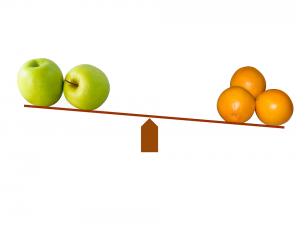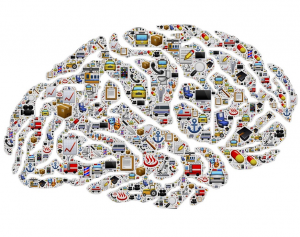Something to Chew On?!
September 7, 2017 Written by: W.B. “Bud” Kirchner
“We use four metaphors a minute, one for every 25 words or so.” – Katy Waldman
 Obviously, something being used so often is important – likely in more than one way and it seems for quite some while: The word originates from the Greek word metaphorá, meaning to transfer, to carry over.
Obviously, something being used so often is important – likely in more than one way and it seems for quite some while: The word originates from the Greek word metaphorá, meaning to transfer, to carry over.
Definition
So we are all on the same page – let’s start with an official/favorite definition of literary terms from Literary Devices.
“Metaphor is a figure of speech which makes an implicit, implied or hidden comparison between two things that are unrelated but share some common characteristics. In other words, a resemblance of two contradictory or different objects is made based on a single or some common characteristics.”
They even dumb it down!
“In simple English, when you portray a person, place, thing, or an action as being something else, even though it is not actually that “something else,” you are speaking metaphorically.
Finally, in an effort to create an operational definition – a metaphor is an ideal vehicle to create an impression with minimum words. The context for this article is two of the implications/applications – focused as always on the world of business.
Background/context
This article is in a sense a bridge (already another metaphor!) between an earlier article on cognition (Augmented Cognitive Performance) and as a prelude to a soon to appear article on creativity so this will be a follow-up to the first and an introduction to the latter – truly a (metaphorical) bridge.
In other words using an earlier article on cognition and a soon to appear article on creativity – we have a context for two of the main uses of metaphors.
- Metaphors are the literal translation of embodied cognition.
- Metaphors (perhaps, because of the above) are a critical component in creativity/innovation – the holy grail in business.
Let me start with some illustrations to make my point. Given the opening quote stats there are lots to choose from but I am focused on those reflecting embodied cognition. (How Embodied Is Your Cognition?)
Metaphors and embodied cognition
None less than Aristotle himself recognized the importance of metaphors.
 Aristotle considered (“ascetics”) metaphor a sign of genius, believing that the individual who had the capacity to perceive resemblances between two separate areas of existence and link them together was a person of special gifts.” and then he added “For to make good metaphors implies an eye for resemblance.” (How To Use Metaphors to Inspire Creative Thinking – Andy Eklund)
Aristotle considered (“ascetics”) metaphor a sign of genius, believing that the individual who had the capacity to perceive resemblances between two separate areas of existence and link them together was a person of special gifts.” and then he added “For to make good metaphors implies an eye for resemblance.” (How To Use Metaphors to Inspire Creative Thinking – Andy Eklund)
We have touched in detail (How Embodied Is Your Cognition?) on metaphors in this context but here are some examples as a reminder.
Metaphorically speaking:
- “Thinking about the future caused participants to lean slightly forward while thinking about the past caused participants to lean slightly backwards. Future is Ahead”
- “Squeezing a soft ball influenced subjects to perceive gender neutral faces as female while squeezing a hard ball influenced subjects to perceive gender neutral faces as male. Female is Soft”
- “Those who held heavier clipboards judged currencies to be more valuable and their opinions and leaders to be more important. Important is Heavy.”
- “Subjects asked to think about a moral transgression like adultery or cheating on a test were more likely to request an antiseptic cloth after the experiment than those who had thought about good deeds. Morality is Purity”
The above are excerpts from A Brief Guide to Embodied Cognition: Why You Are Not Your Brain – Samuel McNerney.
With all the above in mind (body), how can a business person use metaphors to influence thinking in others to enhance self-emotions. Perhaps in a business context it is best thought of as a (the?) form of symbolic reasoning representing an illustration of link between mind and body.
With true metaphorical elegance Katy Waldman describes the process. “Metaphor is that which ferries our attention between the knowable enclave of things and the veiled world of the intellect.”
Metaphors and creativity
“An expert is a person who has few new ideas; a beginner is a person with many.” – Einstein
By encouraging us to look at things (especially familiar things) in a slightly different manner metaphors help avoid the pitfall described by Einstein.
Not to get bogged down in science (This is after all the Business Brain Model) – I find these people fascinating.
The scientist Friedrich August Kekulé discovered the seemingly impossible chemical structure of benzene (C6H6) when he had a dream of a group of snakes swallowing their tails. (Wikipedia)
James Watson, co-discoverer of the structure of DNA, reported stumbling upon the double helix image for the DNA chain through his dream of a spiral staircase. (Wikipedia)
Andy EkLund (How To Use Metaphors to Inspire Creative Thinking) does a nice job of summarizing how metaphors help creative thinking.
- “By identifying similarities between two disparate problems. In doing so, new insights emerge, and can potentially be translated into new ideas to solve the original problem.”
- “By examining the old problem in a new context. Here, a new or different perspective might reveal unusual approaches or potential alternatives to solve the original problem.”
- “By looking elsewhere for answers, particularly outside our existing body of knowledge as well as our comfort zone. As we distance ourselves from our current situation, we give ourselves freedom and clarity to question our assumptions or stereotypes. By breaking these biases, we often can see new solutions to solve the original problem.”
Picking up on the previous article on embodied cognition – I point to you Five Embodied Metaphors That Actually Foster Creative Thinking.
Creativity and embodied cognition – via metaphors
“A person can become more creative simply by changing their posture, establishing a link between creativity and what psychologists refer to as “embodied cognition.” Here’s how you can put their findings to use” – as illustrated by metaphors. (Five Embodied Metaphors That Actually Foster Creative Thinking – Jeremy Dean) This article summarized (from Embodied Metaphors and Creative “Acts” – Leung et al) how metaphors can capture the link between creativity and embodied cognition. I have chosen these examples given their business orientation. Generally speaking the following words are those of Dean.
You can’t help but note how deeply metaphors for creativity are embedded in our consciousness.
On one hand…on the other hand
- When we can think about a problem in terms of two different sides, we are more likely to find a way to integrate them.
- Leung and her colleagues found that test subjects who gestured with both hands came up with more novel ideas than those who gestured with just one hand.
Outside the box
- In creativity you have to try and explore new areas.
- People who were literally sitting outside of a box came up with more ideas than those sitting in the box.
Wander around
- Came up with more ideas when they wandered around randomly than when they walked in a square (or didn’t walk at all).
Put two and two together
- Do the grunt work of logically fitting together ideas or objects we’ve already got.
- “Convergent thinking,”
- A fourth study tested the idea that sorting piles of cards from two stacks into one would encourage convergent thinking.
- Participants who sorted the cards from two piles into one did better on a test of convergent thinking than those who just fiddled around with the cards in one pile.
Imagine it
- Test participants watched a Second Life avatar that was either wandering freely or walking in a square.
- “Psychological embodiment”
- Test subjects watching their freely wandering avatar came up with more unconventional ideas for gifts than those watching the square-walking avatar.
- Because it shows that the postures aren’t as important as the state of mind that they encourage.
Conclusion
I hope I have illustrated (if not documented) how metaphors can help us interpret deep (embodied) cognitive thoughts to make sense of things that are unfamiliar and in doing so:
- Change your perspective
- Assemble various points of view
- Think creatively
- Foster innovation
Bibliography
- Jeremy Dean – Five Embodied Metaphors That Actually Foster Creative Thinking
- Andy Eklund – How To Use Metaphors to Inspire Creative Thinking
- Angela K.-y. Leung, Suntae Kim, Evan Polman, Lay See Ong, Lin Qiu, Jack A. Goncalo, Jeffrey Sanchez-Burks – Embodied Metaphors and Creative “Acts” –
- Samuel McNerney – A Brief Guide to Embodied Cognition: Why You Are Not Your Brain
- Katy Waldman – Metaphorically Speaking
- Wikipedia – List of dreams
Other source
- James Geary – Metaphorically Speaking
About the Author: W.B. “Bud” Kirchner is a serial entrepreneur and philanthropist with more than 50 years of business success. He is not a scientist or an academic but he does have a diversified exposure to neuroscience, psychology and related cognitive sciences. Generally speaking, the ideas he expresses here are business-angled expansions of other people’s ideas, so when possible, he will link to the original reference.
